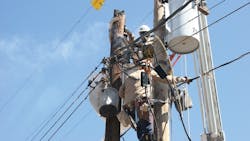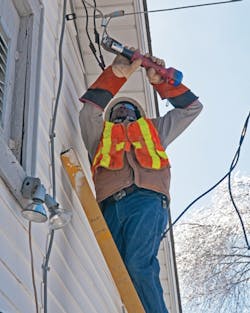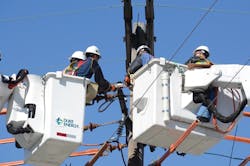Labor-Saving Tools Fuel Productivity
Waves of journeymen are retiring from the electric utility industry, and today’s linemen are challenged by shrinking crew sizes and a heavier workload. To meet these challenges head on, utilities are not only recruiting the next generation of linemen, but they are also investing in technology to improve productivity, safety and reliability.
“Linemen are looking for tools that make their lives easier,” said John West, manager of line construction and maintenance for NV Energy, who has been with the utility for 21 years. “New technology makes them extremely efficient and productive, and, in turn, it keeps costs down and rates lower for utilities.”
As linemen are tasked with upgrading the nation’s aging infrastructure, they are demanding tools that will not only help them to get more work done in less time, but also improve ergonomics so they can work a longer career in the field with fewer injuries, said Keith Meza, a distribution line tech A for Duke Energy.
“My father was a lineman and all my uncles were linemen, and I grew up in this kind of job,” said Meza, who has worked for Duke Energy for 14 years. “When I showed my dad the kinds of tools we have today, he told me he could still be working out in the field if he had then what we have now.”
Enhancing Ergonomics
In the past, linemen had no other choice but to rely on manual tools that, over time, could inflict injuries to shoulders, wrists, back, neck and elbows. Today, manufacturers have come out with tools that are lighter, faster and easier to operate with less fatigue.
For example, at Duke Energy, battery-operated crimpers, drills and ground rod drivers have replaced manual press tools, saving linemen time in the field. It used to take 15 to 20 minutes to drill one hole in a pole with a bracing bit, but it only takes 1 minute with a battery-
operated hammer drill. Meza believes this is good news for Duke Energy’s veteran linemen.
“Ergonomically speaking, the handheld tools were rough on the elbows and shoulders,” Meza said. “Our seasoned linemen aren’t getting any younger, and these tools help to improve productivity. Our company has spared no expense in getting us what we need.”
At the Kansas City Power & Light (KCP&L) service center, linemen stock their bucket truck bins with ergonomic tools like shotgun sticks for working on energized lines and strap hoists to pull new wire to the proper tension following a storm. With the wire tension at more than 1,000 lb (454 kg), it would be impossible to perform this task by hand, said Brian Wahlen, lead lineman splicer.
NV Energy also is starting to invest more into battery-operated, ergonomic cutters and crimpers to use on its underground facilities, said West, who is responsible for the everyday operations of the line department for transmission and distribution in southern Nevada, U.S. In his view, the battery-operated tools have come a long way by featuring batteries that last longer, are more durable and are more lightweight. Also, the tools are now of higher quality and able to stand up to regular use on underground cable, West pointed out.
“We have been experimenting with battery-operated tools for a number of years, and now it’s getting to the point where they’re affordable enough that we can make a serious investment in them,” West explained.
At Ameren Illinois, linemen are getting trained on the importance of ergonomics and how to prevent injuries both on the job as well as at home, said Brian Doran, an electric supervisor.
“The electric industry is really taking a stand on fighting soft tissue injuries,” Doran said. “We are seeing more battery-operated tools that improve the ergonomics of the line workers while they perform their jobs.”
Since Doran first entered the utility industry in the 1980s, he has seen significant improvement in linemen’s tools, ergonomically and functionally.
“We are so more advanced with the smart grid technology on our systems, and we can restore power remotely where we couldn’t do that in the past,” Doran said. “We continue to improve on technology to ensure the best reliability to our customers.”
Tuning into Mobile Technology
Today’s linemen are not only using ergonomic tools in the field, but they are also relying on ruggedized laptops, tablets and smartphones. Mobile technology is no longer a luxury but a necessity in the field.
For example, KCP&L equips its managers with smartphones that receive severe weather alerts. That way, when a storm is on the horizon, the supervisors can notify the linemen out in the field.
“We can tell them that a storm is rolling in and redirect our crews to where they need to go,” explained Tim Jones, supervisor of construction and maintenance for KCP&L.
In addition to smartphones and pagers, KCP&L linemen also rely on Panasonic Toughbook computers hat are tied into the utility’s distribution center. Jones never thought he would see the day when every lineman’s truck was equipped with a laptop computer. Now, the linemen cannot live without the mobile technology, especially during a storm.
“We used to have paper circuit maps, but now they’re all on the computer and updated daily,” Jones said. “Anymore, our computer is like a lifeline. We don’t have to fumble around in foul weather with a wet paper map, and, along with our GPS units, it helps tremendously when we’re sent out of town on storm restoration.”
Wahlen remembers when KCP&L linemen had to store circuit maps in large 3-ft (91-cm)-long boxes weighing about 50 lb (23 kg) each. Because it was impractical or impossible to have a circuit map for every circuit on the system, he was sometimes left without a map, especially when he worked outside his normal service area to restore power following a storm. However, two years ago, KCP&L equipped his truck with a mobile computer loaded with circuit maps.
“It’s very convenient and has completely changed our job,” Wahlen said. “We have hundreds and hundreds of circuits in our area, and our maps took up a lot of space on our trucks. Now that I can access the maps on my computer, it doesn’t matter where I go. I can get critical information, like the location of fuses and switches, so I can properly place grounds and isolate problem areas in the circuit.”
Duke Energy linemen also communicate with their team members via the radio and their computers, which are equipped with a mobile workforce management system (MWMS). At Duke Energy’s Newell Operations Center in Charlotte, North Carolina, U.S., which has about 24 linemen, all the individual service trucks and large construction trucks are equipped with laptops. These computers allow linemen to communicate with supervisors or dispatchers during outages or emergency situations. The MWMS includes detailed information about the transformers, lines, and customers’ names and addresses.
“If I had to go back to a map book, I don’t know what I would do,” Meza said. “It took a little time to get acclimated to a computer, but now, it’s better than sliced bread.”
However, for some of the journeymen linemen, it often takes time for them to learn how to use the mobile technology properly. To keep them up to speed, Duke Energy offers continuing education when a new app is installed or an update is made. At KCP&L, apprentices often teach journeymen how to use the computers, Jones said.
“The young guys are so much more updated electronically that they’re helping our guys to get used to using computers and e-mail,” Jones said. “It’s a win-win situation. There is an evolution that is taking place with each group teaching the other.”
Because the younger generation of linemen expects to have information at their fingertips, PPL Electric Utilities has loaded all of the reference materials, safety rules, construction specs and design instructions onto its laptops. By allowing them to search PDF files of all the guidelines and instructions, they can be more productive, explained Dennis Knepper, director of technical development and improvement at PPL Electric.
“Over the last few years since I’ve been here, we’ve brought a few hundred new linemen on our system,” Knepper said. “For them, it’s the norm to get the information that they need immediately.”
Another way PPL Electric is sharing information and knowledge with its apprentices is by loading training materials on to iPad tablet computers. The utility has replaced its print textbooks with iPads, and, in the future, it hopes to integrate video clips into its training materials to make them more educational and interactive. So far, the utility has invested in a dozen iPads; as each new apprentice class comes onboard, the students will be issued an iPad, Knepper said.
“The iPad is a real money saver,” Knepper said. “I could spend $1,500 on a set of books for one student but only $400 on an iPad.”
The benefit of the iPad goes well beyond the cost savings, Knepper added. The multimedia aspect of the tablet computer allows students to zoom in on pictures, take notes and search for files, all from their desks.
The iPad also could be useful in the field, Knepper said. In fact, PPL Electric is planning on taking the tablet out in the field to see how well it holds up in a utility environment with a specialized protective metal cover. If the iPad does hold up in the field, Knepper sees the tablet one day taking the place of a laptop computer in the work trucks. Not all of the linemen need the full capabilities of a laptop computer, and the iPad may serve their needs while being more portable and less expensive.
In addition, Knepper envisions the iPad, along with the iPhone, will be invaluable for PPL Electric linemen when working storms. He said this technology offers a better way of getting the word out to field crews and contractors than paper-based safety alerts.
“I think this technology would be powerful for storms,” Knepper said. “Instead of handing out a thousand sheets of paper at a storm site, our employees can get inside of our firewall and read the status updates on their iPhone or iPad.”
Also, PPL Electric’s leadership team could use Skype or FaceTime to directly communicate with field crews in a tent city with Wi-Fi capability.
“It would be very easy to have a member of leadership talk to the field folks,” Knepper said. “When they come back to a tent city at the end of the day, they want to know how they did and what is coming up. We could record or live feed the messages, and our employees and aid crews could find out what progress they made that day and where they’ll be heading next.”
Protecting the Field Workforce
While linemen are focused on improving their productivity in the field through mobile technology, they also want to be able to go home safely at the end of each workday. Over the last few years, vendors have introduced products that make it easier for linemen to work safely, even at night.
For example, Duke Energy linemen can now attach light-emitting diode (LED) lights to their hard hats, allowing them to cast light without inflicting a shadow or getting light directly in their eyes.
“The LED lights can shine really brightly so you can see what you’re doing at night,” Meza said. “When you’re working in a hole and digging underground, you can see where you’re going.”
During the daytime, Duke Energy linemen can pull down the flame-retardant sun visors to protect themselves from ultraviolet rays. In addition to these hard hats, which are more lightweight than previous models, the linemen wear boots that last longer and are more comfortable.
“Boots used to be hot and heavy, but now they’re better for feet, ankles and legs,” Meza said. “They’re better to climb in because your feet won’t get as fatigued. If you’re working on a pole all day long, you don’t want to wear out your feet and legs.”
Duke Energy linemen also wear all-leather hand gloves, which are tough, durable and last a long time. In addition, the field workforce must wear flame-retardant garments. Through an allowance, the linemen can order shirts, pants and other garments from Carhartt.
KCP&L crews also must wear flame-retardant clothing in the field. Over the years, manufacturers have made flame-retardant clothing more breathable, comfortable and wearable, and the garments are easier for linemen to work in, even in extreme weather conditions.
“There are no ifs, ands or buts about it. It is mandatory that we wear it in the field,” Jones said. “But we are so used to it that you almost take the clothing for granted anymore.”
In addition to flame-retardant clothing, linemen at an increasing number of utilities are required to wear full fall protection. For example, after seeing other utilities mandate fall protection at the International Lineman’s Rodeo, Hawaiian Electric Co. decided to shift to full fall protection, said Fred Kana’i Kauhane, a training supervisor in the construction and maintenance department. The linemen use the BuckSqueeze system on poles and belts on towers. After five years, the utility is starting to see a difference as far as safety records, he said.
“We went through some hard times getting everyone onboard, but now we have 100% participation,” Kauhane said. “Our old-timers are saying great things about it and how comfortable they feel when they watch our apprentices climb. Our safety record has also improved, and we’re reaping the benefits of fall protection now.”
Duke Energy has been using 100% fall protection for the last six years, and the company’s linemen must use full-body harnesses in bucket or line trucks. The fall-
restraint system has helped apprentices during their training.
“Some of the guys are inexperienced climbers, and they’re afraid of going up the pole,” Meza said. “The fall protection gives them the confidence to climb.”
At PPL Electric, linemen use fall-protection devices from Jelco and Buckingham Manufacturing. At first, they used a belt and D-ring as fall protection and then moved to a body harness over the shoulders. Now the utility uses a full-body harness with rigging in the front or the back. As the bucket stops or breaks in the air, linemen can hook it up front, rig up a self-rescue system, repel out of the bucket and get down safely.
The utility requires full fall protection on wood poles and on towers. In fact, the utility helped to develop the industry’s first transmission tower fall-arrest system. Linemen are adding brackets for the RapidRail vertical ascent system on all new transmission towers so they can attach themselves and climb the towers with 100% fall protection.
“We’ve had other utilities come out to see the system that we have built,” Knepper said. “Free-climbing towers will be a thing of the past.”
Improving Productivity on the Go
With flame-retardant clothing and fall protection increasingly being mandated at utilities nationwide, linemen need a place to store these items and other supplies safely while on the go.
For linemen, bucket trucks have long been a necessity, and, over the years, manufacturers have added specialized storage bins, remote control options and material handlers, all of which help linemen to improve productivity and safety in the field. In fact, Jones said the bucket trucks have become so advanced that, while it used to take a line truck and bucket truck to hang a transformer, now it only takes one Altec truck and two linemen to do the job.
Bucket trucks also are vital to Xcel Energy’s field crews, said Scott Hindman, supervisor 2 for Xcel Energy. In his service area, linemen can use a bucket truck to reach nearly every pole in the system. Because the linemen can position their trucks to where they can greatly improve efficiency and safety, they also can help with
ergonomics, he said.
“We want our employees to spend their whole careers with us, and so we provide bucket trucks, tools and equipment to make their job easier and less strenuous,” he said. “The bucket trucks cut down on sprains and strains, and it makes it easier for them to do the work without climbing poles day in and day out.”
In addition to relying on bucket trucks and digger derricks, utilities also are turning to helicopters to transport both linemen and materials to remote job sites. For example, NV Energy uses helicopters for line patrols, to replace poles in remote areas and to install aerial markers on transmission lines.
By relying on helicopters, ergonomically designed bucket trucks and efficient tools, linemen are finding ways to save labor and protect themselves from injury. Today’s technology empowers linemen to enjoy a long career in the field and play a critical role in upgrading the nation’s infrastructure.
About the Author
Amy Fischbach
Electric Utilities Operations
Amy Fischbach is the Field Editor for T&D World magazine and manages the Electric Utility Operations section. She is the host of the Line Life Podcast, which celebrates the grit, courage and inspirational teamwork of the line trade. She also works on the annual Lineworker Supplement and the Vegetation Management Supplement as well as the Lineman Life and Lineman's Rodeo News enewsletters. Amy also covers events such as the Trees & Utilities conference and the International Lineman's Rodeo. She is the past president of the ASBPE Educational Foundation and ASBPE and earned her bachelor's and master's degrees in journalism from Kansas State University. She can be reached at [email protected].



